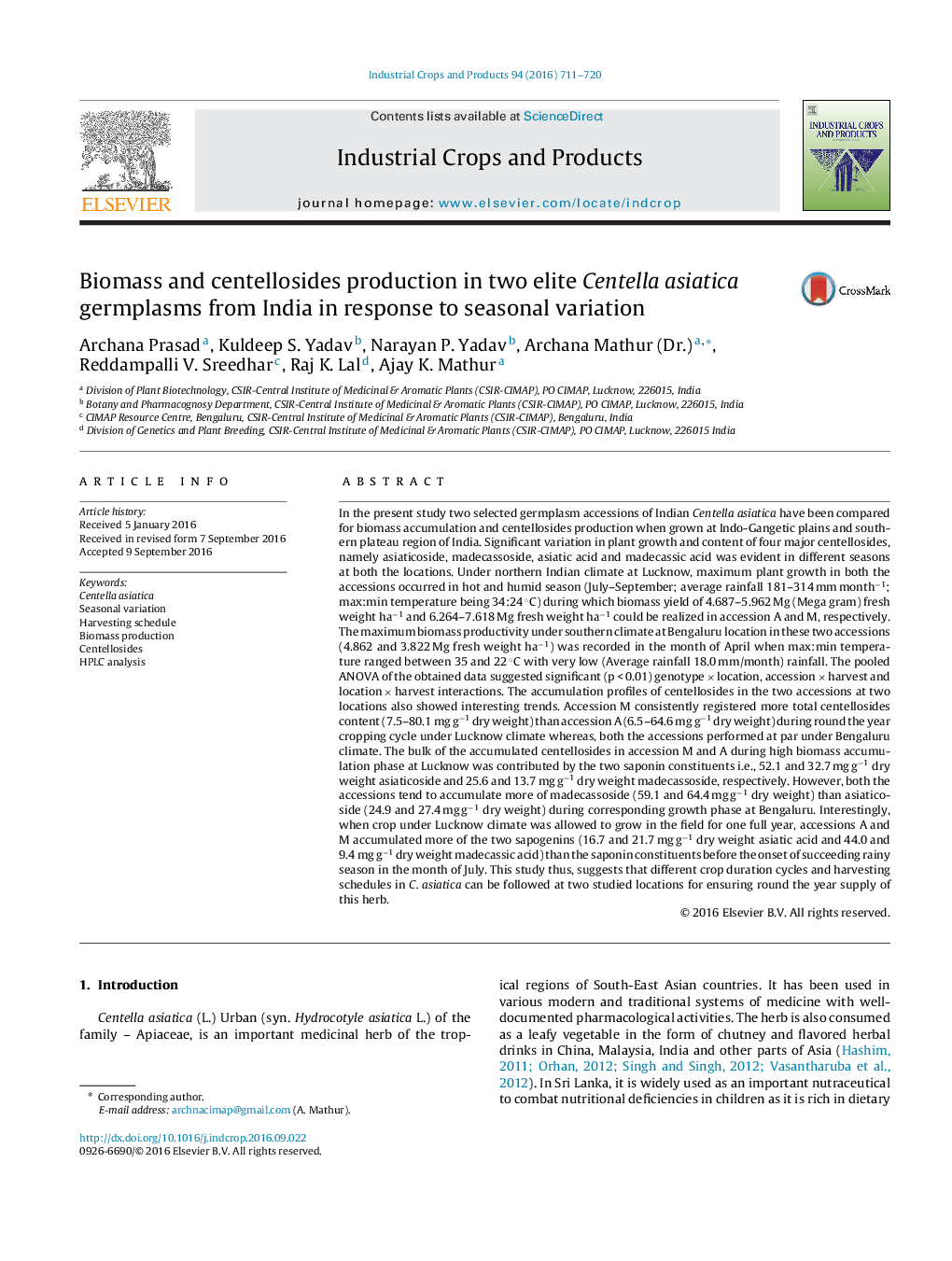| کد مقاله | کد نشریه | سال انتشار | مقاله انگلیسی | نسخه تمام متن |
|---|---|---|---|---|
| 6375425 | 1624816 | 2016 | 10 صفحه PDF | دانلود رایگان |
عنوان انگلیسی مقاله ISI
Biomass and centellosides production in two elite Centella asiatica germplasms from India in response to seasonal variation
دانلود مقاله + سفارش ترجمه
دانلود مقاله ISI انگلیسی
رایگان برای ایرانیان
کلمات کلیدی
موضوعات مرتبط
علوم زیستی و بیوفناوری
علوم کشاورزی و بیولوژیک
علوم زراعت و اصلاح نباتات
پیش نمایش صفحه اول مقاله

چکیده انگلیسی
In the present study two selected germplasm accessions of Indian Centella asiatica have been compared for biomass accumulation and centellosides production when grown at Indo-Gangetic plains and southern plateau region of India. Significant variation in plant growth and content of four major centellosides, namely asiaticoside, madecassoside, asiatic acid and madecassic acid was evident in different seasons at both the locations. Under northern Indian climate at Lucknow, maximum plant growth in both the accessions occurred in hot and humid season (July-September; average rainfall 181-314 mm monthâ1; max:min temperature being 34:24 °C) during which biomass yield of 4.687-5.962 Mg (Mega gram) fresh weight haâ1 and 6.264-7.618 Mg fresh weight haâ1 could be realized in accession A and M, respectively. The maximum biomass productivity under southern climate at Bengaluru location in these two accessions (4.862 and 3.822 Mg fresh weight haâ1) was recorded in the month of April when max:min temperature ranged between 35 and 22 °C with very low (Average rainfall 18.0 mm/month) rainfall. The pooled ANOVA of the obtained data suggested significant (p < 0.01) genotype Ã location, accession Ã harvest and location Ã harvest interactions. The accumulation profiles of centellosides in the two accessions at two locations also showed interesting trends. Accession M consistently registered more total centellosides content (7.5-80.1 mg gâ1 dry weight) than accession A (6.5-64.6 mg gâ1 dry weight) during round the year cropping cycle under Lucknow climate whereas, both the accessions performed at par under Bengaluru climate. The bulk of the accumulated centellosides in accession M and A during high biomass accumulation phase at Lucknow was contributed by the two saponin constituents i.e., 52.1 and 32.7 mg gâ1 dry weight asiaticoside and 25.6 and 13.7 mg gâ1 dry weight madecassoside, respectively. However, both the accessions tend to accumulate more of madecassoside (59.1 and 64.4 mg gâ1 dry weight) than asiaticoside (24.9 and 27.4 mg gâ1 dry weight) during corresponding growth phase at Bengaluru. Interestingly, when crop under Lucknow climate was allowed to grow in the field for one full year, accessions A and M accumulated more of the two sapogenins (16.7 and 21.7 mg gâ1 dry weight asiatic acid and 44.0 and 9.4 mg gâ1 dry weight madecassic acid) than the saponin constituents before the onset of succeeding rainy season in the month of July. This study thus, suggests that different crop duration cycles and harvesting schedules in C. asiatica can be followed at two studied locations for ensuring round the year supply of this herb.
ناشر
Database: Elsevier - ScienceDirect (ساینس دایرکت)
Journal: Industrial Crops and Products - Volume 94, 30 December 2016, Pages 711-720
Journal: Industrial Crops and Products - Volume 94, 30 December 2016, Pages 711-720
نویسندگان
Archana Prasad, Kuldeep S. Yadav, Narayan P. Yadav, Archana Dr., Reddampalli V. Sreedhar, Raj K. Lal, Ajay K. Mathur,